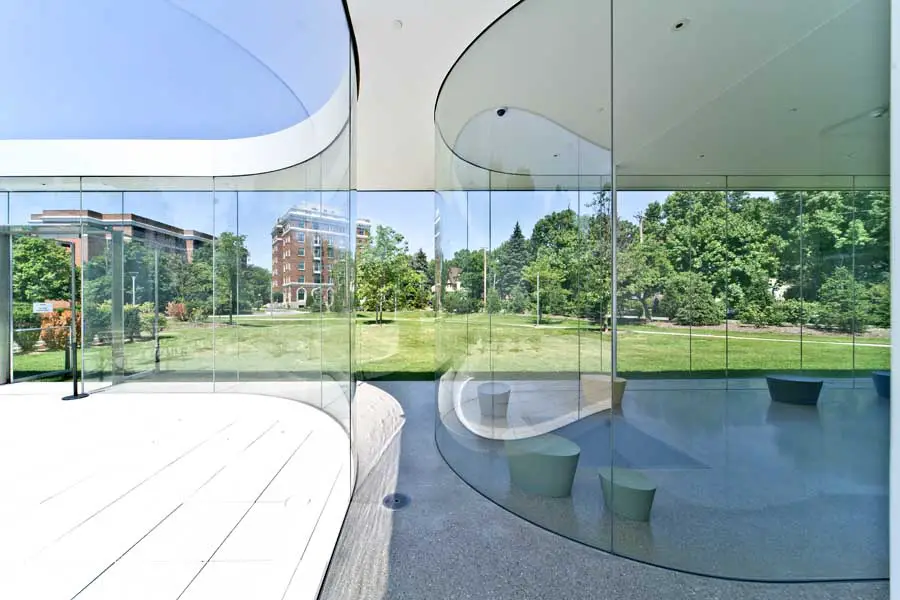Glass Carbon Emissions, Architecture Article, Sustainable Building Design Images
Glass Carbon Emissions Reduction
Architecture Discussion by Clemens Miller of NSG Group
10 May 2011
Glass : the clear solution to the carbon emissions challenge
Glass can play a vital role in reducing carbon emission, says Clemens Miller of NSG Group.
With climate change now firmly on the world’s political and environmental agenda, and global energy supplies under pressure from increasing demand, the flat glass industry is poised with solutions to reduce our carbon emissions.
In an era of global challenges requiring global solutions, cutting carbon emissions is possibly our greatest yet. Glass can play a vital role in this challenge; providing carbon saving solutions on two fronts. It can make a huge contribution to saving energy in buildings, as no other material has a more powerful influence on the energy performance of a building than glass.
It is also a key component of the solar panels used to generate renewable energy, which also cut fossil fuel consumption. Furthermore, as the energy consumed in the manufacture of high performance glass is quickly paid back through the lifetime of most of the products, it is an effective, ‘energy-balanced’ solution.
Toledo Museum of Art Glass Pavilion by SANAA:
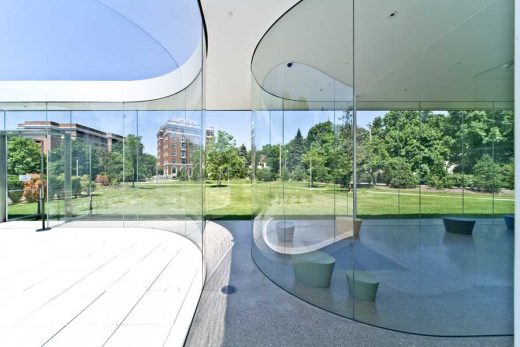
image from BM
The incentives are clear; with the stark realities of climate change making the need to reduce emissions a global political priority, governments are increasingly turning to legislation in order to achieve these reductions. The Kyoto protocol, adopted in 1997 and enforced in 2005, sets binding targets for controls and cuts in greenhouse gas emissions, and this has led to the development of numerous initiatives to encourage greater energy efficiency in buildings.
For example, the EU Energy Performance of Buildings Directive aims to ensure all new buildings in Europe are ‘nearly zero energy’ by 2020, whilst the 2012 International Energy Conservation Code (IECC) in the USA is expected to achieve a 30% increase in energy savings in both residential and commercial buildings compared to its 2006 predecessor.
A recent study from the European Commission suggests that buildings account for up to 50% of energy consumed in the EU, significantly more than the 36% consumed by the transport sector. Since regulations are already in place to ensure new buildings are energy efficient, the challenge lies in improving the performance of existing building stock worldwide, especially in developed countries.
The majority of these were constructed at a time when energy efficiency was not a concern for architects and designers, resulting in significant energy waste. Older homes may not be benefitting from the insulating effects of efficient double-glazing, while the larger glazing areas of commercial properties may not have been designed as efficiently as possible, thus requiring additional heating or cooling systems to provide a comfortable environment.
There is, however, real scope for glass to be used effectively to reduce the carbon footprints of these buildings. An independent study on low-e insulating glass commissioned by European trade association Glass for Europe shows that, within the EU alone, fitting energy efficient glazing to existing and new buildings could save up to 97 million tonnes of CO2 emissions annually by the year 2020.
This equates to almost a third of the annual carbon emissions reduction target of 300 million tonnes set out in the EU Directive. Industry studies also show that this glass will offset the extra CO2 emitted during its manufacture compared with an equivalent single glazed pane within four months of installation.
Turku Library Building:
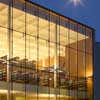

image from BM
Whatever the requirement, wherever in the world, glass products offer effective solutions. In cold climates, low-emissivity glass prevents heat escaping, while still allowing solar heat to enter the building. In warm climates, solar control glass minimises heat entering the building, while still letting lots of natural daylight in. This means buildings are always comfortable for their occupants, without the need to compromise on building aesthetics, and that they require less heating, cooling and lighting through traditional carbon-intensive methods.
Additionally, energy efficient glazing products can be retrofitted to improve the efficiency of existing structures. For example, Pilkington Spacia™, the world’s first commercially available vacuum glazing, offers the thermal performance of a conventional double glazing unit despite being no thicker than a single pane of glass. This allows architects to balance historical preservation with modern comfort and environmental requirements.
Glass also has an important role to play in sustainably sourcing the energy consumed in buildings. As an integral and important element of solar panels, glass can help in the shift to ever ‘cleaner’ energy generation. The NSG Group offers a wide range of high-tech functional products used in the three leading technologies that convert solar energy into electricity: thin film photovoltaics, crystalline silicon photovoltaics and concentrated solar power applications, and the Group’s products are also used in solar applications that generate hot water.
The glass used in these applications also provides a healthy return on the energy investment used in its manufacture, and during its lifecycle a solar panel can produce over 15 times this amount of energy. This is an industry sector set to grow massively over the coming years, as forecast by the European Photovoltaic Industry Association (EPIA), the world’s largest industry association devoted to the photovoltaic market. Just last year, the market roughly doubled compared with 2009, and as the ramifications of the Kyoto protocol and other guidelines hit home, 2011 is set to be an even bigger year.
Vilnius airport business centre (office building) – Lithuania – using Pilkington Suncool™ Blue 50/27 – Architect: Leonidas Merkinas:
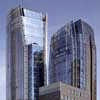
image from BM
These are not just solutions for the future; the technology found in these products is available today. Unlike many of the other potential solutions to the carbon emissions problem mooted, which often require further advancements in their respective fields or significant investment in infrastructure before they can be rolled out globally, all of these glass products are already on the market. However, for both energy saving and energy generation applications, key stakeholders such as homeowners and power companies face the same concern; cost.
While the long-term financial benefits of energy efficient buildings are clear, particularly to owner-occupiers, the initial cost of replacing an entire building’s windows can often be prohibitive. Similarly, until the price of fossil fuels becomes too steep, power companies will be reluctant to invest significant amounts of money in solar power.
There is no doubt that glass has a key role to play in reducing carbon emissions. With its global network of production and distribution capabilities, and commitment to effective lobbying for a greener energy future, the NSG Group will continue to create and promote the effective solutions required for this. The onus to implement these technologies now lies with individuals, businesses and governments.
Individuals and businesses must recognise the intrinsic value glass has in the battle to cut emissions and save money, and governments must strike the right balance between legislative demands and financial incentives to ensure their efficiency targets are met. If this happens, glass will continue to transform our lives well into the 21st century.
Cambridge Water Company, England:
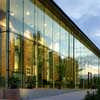
image from BM
About: In 2006, Pilkington plc was acquired by the NSG Group of Japan, and the name Pilkington was retained as a brand for the Group’s building and automotive products. Today the NSG Group is one of the world’s largest manufacturers of flat glass products for the building trade, the automotive industry and technical applications.
For more information: www.pilkington.com
Do you have a view on the points raised by Clemens Miller in this Glass Carbon Emissions article? If so, please e-mail info(at)e-architect.com
Sustainable Architecture Articles
Ecocities, London
LEED System : View by Romi Sebastian. 12 Aug 2010
Biomass : discussion by Alastair Kerr, Director General. 29 Mar 2010
Globalisation Architecture : article by Trevor Tucker. 8 Jun 2010
Wood Panel Industry : article by Alastair Kerr, Director General. 29 Mar 2010
Sustainable Architecture Design : article by Trevor Tucker. 18 Aug 2009
Sustainable Buildings : article by Adrian Welch. 12 Sep 2006
Apple Michigan Avenue, Chicago, IL USA
Architects: Foster + Partners
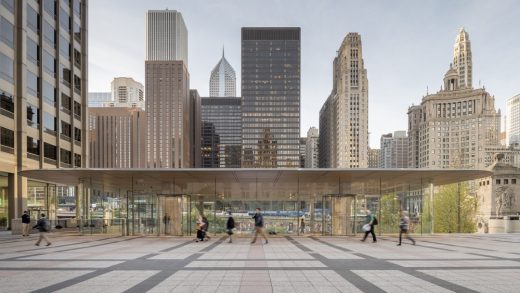
photography © Nigel Young Foster + Partners
Apple on Michigan Avenue
Comments / photos for the Glass & Carbon Emissions Reduction page welcome

